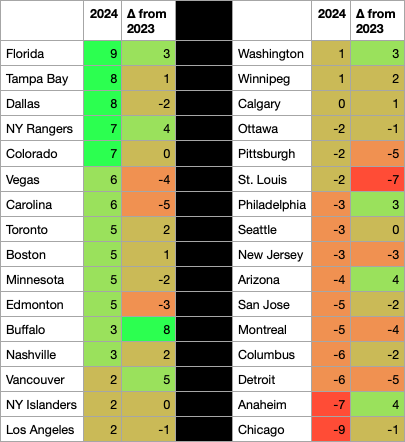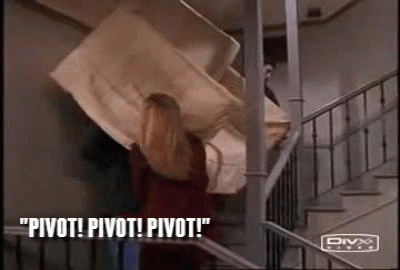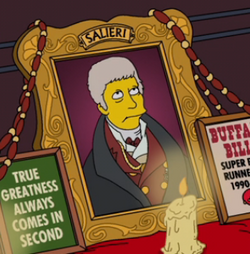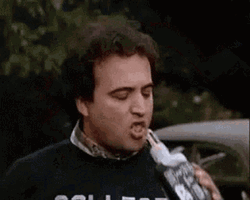It’s hot, it’s muggy, and it’s August, so that means it’s time for my annual Mediocrity Project update! Let’s get right to the ratings!

Top and Bottom Teams
The Stanley Cup champion Florida Panthers sit atop the update with a +9, an improvement of 3 points from last season. Makes sense, they got 2 points for making a Conference Finals and Cup Finals appearance, but also that their five-year winning percentage climbed into the top quintile earned them another point. They are joined in the top group by Colorado, Dallas, the Rangers and Tampa Bay.
Notably, of that group only the Rangers haven’t won a championship lately, but their Conference Finals appearance this past June, their consistently improving regular season winning percentage, and the fact that their recent top-ten draft picks have aged out of the metrics for draft picks gave the Rangers four more points from last year. They’re clearly a team possibly making the Finals in the next year or so.
The other three (Colorado, Dallas, and Tampa Bay) might not be in as strong a position to win a Cup as they were in previous years thanks mostly to their aging rosters and relatively weak prospect pools, and they each had poor offseasons (especially the Stars and Lightning with the retirement of Joe Pavelski and the departure of Steven Stamkos, respectively). Meanwhile the Avalanche have plenty of their own questions including the uncertainty about the returns of Gabriel Landeskog and Valeri Nichushkin. There’s good reason to believe each of these teams will continue to decline.
Also worth noting is the other Stanley Cup finalist, the Edmonton Oilers, did not get treated kindly by my model. Although they added two points for making the Conference and Cup Finals, they gave up those gains by having one of the oldest rosters in the League, as well as in having one of the least-regarded prospect pools and having a middling offseason. As a result they fall back to the second tier of teams that are mostly somewhat-serious championship contenders.
On the other end of the discussion are the Chicago Blackhawks at -9, taking over last place from the Anaheim Ducks (who haven’t gotten much better at -7). The biggest difference is the average roster age: Anaheim has one of the youngest rosters in the NHL and got a +2 for that metric, while Chicago has a relatively older roster and are still a couple of years from their prospects starting to mature, and as such got a -1. But the Blackhawks did have the League’s most improved offseason, so they got a +2 on that versus the Ducks’ +1. They both had top three picks this summer, but the penalties have been offset by improvements in other areas. In any event, they’re likely still a couple of seasons away from getting out of the basement and back into the playoff chase.
We also see towards the bottom some of the familiar rebuilding teams: Columbus, Detroit, Montreal, and San Jose have regressed from last year, mostly thanks to top-five draft picks by each team except the Red Wings (I’ll get to them in a minute). You would reasonably think that it’s only a matter of time for those teams to start moving up, although with Detroit…
Biggest Movers

By far the most improving team in the NHL are the Buffalo Sabres, going +8 (-5 to +3) from last season. Their year-over-year winning percentage is creeping upwards, their draft picks have been aging out, and they made some good improvements this offseason. Now they have to avoid falling into the trap of the Mediocrity Zone (like their aforementioned peers in Detroit), which means continuing to improve their regular season performance and making the playoffs.
Likewise, the Vancouver Canucks have also gone from the negative side to the positive in a substantial way with a +5 to bring them from -3 to +2, but they perhaps have more to prove than the Sabres after spending most of last season in the Presidents’ Trophy race. Is there reason for optimism in the Pacific Northwest after the Canucks’ first playoff series win since 2020, or will it prove to have been a fluke…like it was after 2020?
Three teams added four points this offseason: besides the Rangers (up to +7), the Anaheim Ducks and the Utah Hockey Club (née Arizona) were also +4 as their youth movements have started to pick their rosters up out of the NHL basement. In a few years they’ll likely be joining Buffalo in the playoff hunt.
There’s a bunch of teams sinking, but none as hard as the St. Louis Blues who have suffered the biggest drop since the Anaheim Ducks fell seven points last offseason. Of course, the Ducks were tanking for a rebuild and went from -4 to -11, and as I just mentioned they are now starting to swing back upwards. St. Louis is in a different boat as they are now six years removed from their championship (which drops them by -2) and their year-over-year regular season performance has also seen the Blues slowly degrading from a clear playoff team to a borderline one. This degradation has caused them to go from +5 to -2 overall. Slowly decaying is not a good recipe for a rebuild, and now there will be fears that St. Louis will merely hang around as opposed to putting themselves in the tank like they probably ought to.
The next biggest fallers at -5 are an odd trio in context: Carolina, Detroit, and Pittsburgh (into which I’ll go into further detail shortly). The Hurricanes were top of the League last year at +11 despite not making it to the Cup Finals, so losing five points to go to +6 is a warning that their championship window might be closing. The Red Wings were looking like they were heading in the right direction, from -8 in 2021 to -1 last offseason, but their roster is suddenly one of the oldest in the League as the Yzerplan has yet to materialize as GM Steve Yzerman probably was hoping. The Penguins as we all know are kind of stuck in the mud as they are relying on their aging vets to shoulder the heavy lifting while they wait for Lady Luck to send them a few young non-lottery tickets to maybe cushion the end of the Crosby/Malkin/Letang era. These three teams are all in different mindsets so it’s interesting to see how they’ve all suffered from their recent lack of success.
The Antonio Salieri Paragons of Mediocrity

The Mediocrity Zone, per this method, are the teams in the +2 to -2 range. Some teams pass through this range on their way up or down, and that’s fine since they’re either in the playoff hunt or the lottery hunt. If your aim as a team is to be successful, well, success is typically measured in championships. Teams heading up these rankings are those with genuine aspirations for winning the Cup in the near future, while those who are heading down are looking further ahead. However, teams that hang around in the Mediocrity Zone for years on end are in rough shape because they’re neither improving nor declining, and that is effectively death for a franchise and its fanbase. When a team is neither bad nor good, fans lose interest, players lose interest…it’s a recipe for disaster to not know when to blow things up.
Because this project is about highlighting mediocrity, there are four teams in particular that I want to poke fun at for being stuck in mediocrity for successive years. These are teams whose fortunes haven’t budged significantly in one direction or another. Maybe they’ve made a playoff appearance or two, or maybe they’ve been waiting for prospects that haven’t met their expectations, but in any event these teams are chronically stuck in neutral with seemingly no hope to escape but a change in fortunes for the better or the worse.
First up are the Ottawa Senators. Of the four teams being mentioned in this segment their score has changed those most since I started this project back in 2021, from -7 to -2, but the Senators have been anxiously awaiting a golden generation that has not come to fruition at all. From last year their score has gone down by one point, led mostly by the fact that their prospect pool is now considered one of the weakest in the NHL. Their primary hope now is that whatever they were hoping for from their maturing young players does eventually come around, but they are in danger of falling behind their rebuilding Atlantic Division peers in Buffalo and Detroit, and possibly getting passed by Montreal at some point as well (although that may not be such a bad thing if they need a jolt to their farm system).
Next are the Winnipeg Jets. Ah, what disappointment they insist on being. Despite having one of the top three goaltenders in the League, one of the top ten defensemen, having a fairly healthy year last year, and having an average prospect pool, they had an awful offseason by Dom Luszczyszyn’s reckoning, and they continue to flame out in the first round of the playoffs. They have good depth, but their main issue for me is the lack of an out-and-out offensive superstar, someone who will produce a point-per-game or better and consistently. They did improve from last season’s mediocrity score, but only marginally (+2), and that’s not enough for a team that’s in the middle of the pack. If no one steps up in that regard, I’m afraid they’re going to be stuck until Hellebuyck decides he’s had enough.
Now we’re getting to the good stuff, as the second-most mediocre team in the NHL, very slightly improved at +1, are the Calgary Flames. Last season, Alberta’s other team finished fifth in the Pacific Division for the second year in a row and for the third time in four years. (That other time, in 2021-22, it was their second-best season ever but they got smoked in the second round by their Albertan rivals, the Edmonton Oilers.) Their best players are mostly castoffs from other teams: Mackenzie Weegar, Jonathan Huberdeau, Nazem Kadri, Rasmus Andersson, and Jake Bean to name a few. Despite having a top ten pick in the last three years, their prospect pool is average. Their roster’s average age? League average. They don’t have any consistent performers on offense or defense. They have a highly-regarded goaltending prospect in Dustin Wolf, but he will likely be wasted on such a…mediocre team, unless they decide to cut their losses and head for the NHL basement.
Finally, the only team that seemingly benefitted from COVID-19, the best of the blah, the champions of crumminess, the masters of mediocrity: the New York Islanders! In the 2020 and 2021 bubble hockey seasons they were “conference”/semi-finalists, and they’ve made the playoffs two years in a row. Nevertheless, their mediocrity score has gone effectively unchanged since the 2021 offseason as they are +2 now just as they were then. Before this summer with Cole Eiserman at 20th overall, the Islanders hadn’t made a first round pick since 2019, and they haven’t made a top ten pick since 2014 when they made an impressive whiff on Michael Dal Colle in a very deep draft. They got a surprisingly subpar season out of Ilya Sorokin last year, but they had a couple star seasons from Mat Barzal and Noah Dobson to cancel that out.
Let’s Not Forget the Penguins!

As I mentioned in the Top Movers section, Pittsburgh fell by five points between last and this offseason, from a modestly positive +3 to a negatively mediocre -2. For context there were three other teams that were +3 last offseason: the Rangers (+4) and Toronto (+2) went up and Los Angeles (-1) went down. Here is what caused the Penguins score to change:
- They lost a point for their three-year regular season winning percentage going from the second to third quintile
- They lost a point for their three-year regular season winning percentage being lower than their five-year regular season winning percentage
- They lost two points for not making the playoffs more than once in the last three years or more than three times in the last five years
- They gained a point for not having made 4-5 playoff appearances without a Conference Finals appearance
- They gained a point for their prospect pool going up a quintile
- They lost two points for having a middling offseason improvement ranking
So the big picture that we’re all familiar with is that Pittsburgh has been regressing in the regular season over the past several years and, combined with a couple of missed playoff appearances, they have lost a few points as a result.

